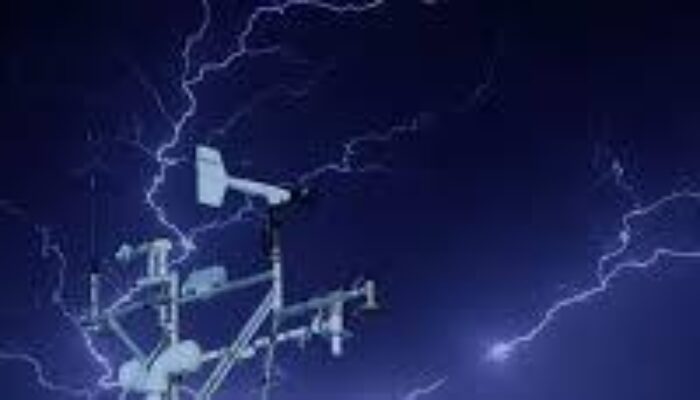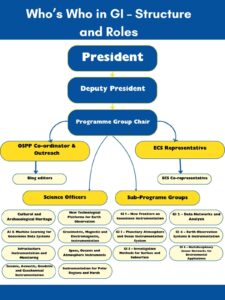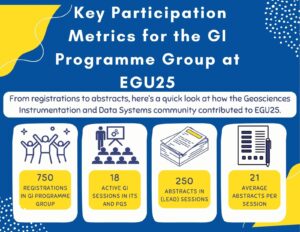
The Geosciences Instrumentation and Data Systems (GI) Division is one of the many divisions within the EGU. However, have you ever wondered what the GI division does? Our mission is to advance geoscientific research by promoting innovation, collaboration, and knowledge exchange in instrumentation, technology, and data systems across all geoscience disciplines. We are an interdisciplinary division, covering every area of Geoscience, from developing novel instruments for exploring planets to advancing next-generation data systems. In this blog, we’ll walk you through what the GI Division is all about, how it’s structured, and the benefits of being a member. We hope it helps you better understand and make the most of being part of this interdisciplinary and collaborative community.
So, let’s start with the basics of how the GI Division is structured, who’s behind the scenes keeping things running, and how we come together each year at the EGU General Assembly (GA) to share ideas and showcase innovation.
Structure, Community & General Assembly
The GI division is managed by a team of scientists and volunteers who work together to support its progress, development and continuous improvement (see the diagram below illustrating the division’s structure). At the head is the President, who provides strategic leadership and represents the division within the broader EGU framework. The President plays a key role in shaping scientific priorities, supporting community initiatives, and ensuring that our division remains an active and prominent voice in geosciences.
Supporting the President are the Science Officers, who help coordinate scientific activities across the division throughout the year. Within the division, we also have sub-programme group leaders who focus on specific topic areas, helping to structure the content presented at the GA and guide ongoing discussions. The GA is held annually at the Austria Center Vienna (ACV) in Vienna, Austria and online. It is a major international conference for geoscience, and one of the key moments for our division.
Since most participants at the GA are Early Career Scientists (ECS), defined as those within seven years of completing their last degree, one of the key roles in the division is the ECS Representative (Rep) and Co-Representative (Co-Rep). They advocate for junior-level scientists and actively engage with them through events, outreach, and support initiatives.
Importantly, most roles within the division, whether in leadership, sub-programmes, or the ECS team, rotate regularly. This rotation brings fresh perspectives, allows transparency and offers members the chance to take an active role in the division. For this reason, being a new member (ECS or senior-level) is especially valuable, as it helps sustain the division’s innovation and growth. New members are always welcome!
How does a GI member make a difference?
As a member of the GI Division, you’ll have numerous opportunities to showcase your work by presenting and publishing your research in diverse settings. For example, you can collaborate with experts in instrumentation, software, and data systems through our events. These are informal online meeting where GI members can discuss with experts sharing their experiences on specific topics.
Also, as a member, you can actively contribute to the GA by convening and proposing sessions, suggesting ideas for Short Courses, Union Symposia, and Great Debates, and participating in decision-making processes that shape the future of GI division. All members are welcome to contribute ideas. The application process for involvement takes place in the year following the last GA – so be sure to watch your inbox and follow our announcements to stay up to date on important deadlines and opportunities. Key announcements and upcoming events (e.g. Campfires) are regularly shared on our social media channels, LinkedIn and Bluesky.
As a member of the GI Division, you can also participate by nominating colleagues to recognise their outstanding contributions to geoscience. In the GI division, this includes nominations for the senior-level Christiaan Huygens Medal and the Division Outstanding Early Career Scientist Award for junior-level. Also, if you are an ECS presenting a poster, PICO, or talk at the next General Assembly, don’t forget to apply for the Outstanding Student and PhD Candidate Presentation (OSPP) award, which aims to recognise remarkable presentations at the GA. Take a look at past awardees (ECS and senior-level) to get inspired and see the kind of research and impact that is shaping the GI community.
Whether or not you are a member, you are welcome to submit your papers to either of the two GI journals: Geoscientific Instrumentation, Methods and Data Systems or Geoscientific Model Development. Both journals play a crucial role in our community. You can also explore highlighted articles selected by the journal editors, showcasing the most relevant research to keep you informed. These journals are open access and has a moderate article processing charge (APC) – members also received 10% discount. They are among the few journals offering an interactive public peer review process, which makes the whole process more transparent and gives authors a chance to engage openly with feedback. Plus, authors from economically disadvantaged European countries or those listed by Research4Life are eligible for standard discounts or waivers (see this link to explore the available options). These features are consistent with the standards of all EGU journals.
Our next steps: Building on Insights from last GA
The last GA was held in April 2025 as a hybrid event (see EGU25), setting a new record with over 20,984 of which 18,646 made their way to Vienna from 120 countries and 2,338 joined online from 104 countries. It was a great success with 18,934 presentations given in 1,102 sessions. Thereby, 56% of the abstracts were identified as contributions from Early Career Scientists (ECS). Although our community is already interdisciplinary, we recognise the opportunity to expand further by identifying more engaging topics to inspire future sessions at GA. This represents a key goal for the coming years, one that will help us grow our members and advance together in both scientific impact and knowledge.
The GI Division encompasses a broad and rapidly evolving range of topics, from open hardware and small satellites to AI in remote sensing and real-time hazard monitoring. Future goals for the GI community include expanding the GI blog as a key platform for visibility and outreach, organising virtual events such as Campfires, promoting ECS-led initiatives and increasing communication through our social media channels. We envision this blog as a space to connect with our members and the general public and highlight the exciting research happening across the GI division. We’ll also showcase how working across diverse disciplines is a big part of what makes the GI community so innovative. Look forward to future articles exploring key research, emerging technologies, and impactful collaborations from within our division.
The division continues to grow its global engagement and provide valuable opportunities for its members, especially early-career scientists. We invite new members to join us —subscribe to our email list (for both ECS and senior-level) and become part of a community advancing geoscience through advance instruments, innovative data systems, collaborative efforts, and impactful research.


